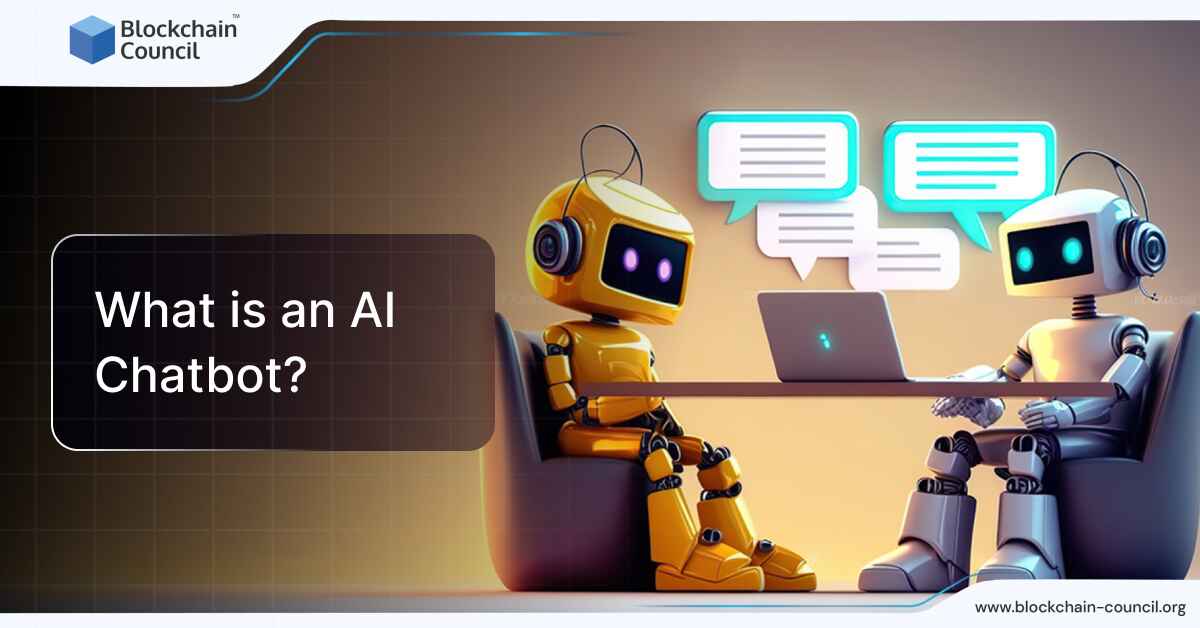
- Blockchain Council
- September 02, 2024
Summary
- AI chatbots are experiencing unprecedented growth, driven by the demand for enhanced customer service and operational efficiency in businesses.
- These chatbots leverage AI to simulate human conversation, providing instant responses and improving user experience.
- AI chatbots use natural language processing (NLP) to understand user queries and select appropriate responses, learning and improving over time.
- They offer various benefits such as time and cost efficiency, multilingual support, and improved customer insights.
- Different types of AI chatbots include customer service bots, sales and marketing bots, feedback and survey bots, multilingual bots, and personal assistant bots.
- Despite their advantages, AI chatbots face challenges like inaccuracies, complex issue handling, lack of human connection, and security concerns.
- The future of AI chatbots holds promise with advancements in NLP, multitasking capability, emotional intelligence, security, and scalability.
- Key features for future AI chatbots include advanced NLP, multitasking capability, emotional intelligence, security, and integration.
- Despite challenges, AI chatbots represent a significant advancement in digital interactions, offering personalized and accessible communication.
- As technology evolves, AI chatbots are expected to become more integrated into daily life, shaping the future of digital communication.
The digital landscape is witnessing an unprecedented surge in AI chatbot adoption. These advanced computer programs leverage Artificial Intelligence (AI) to simulate human conversation, providing instant responses to user queries. With the chatbot market size projected to reach USD 7.01 billion by 2024, the significance of chatbots in modern business cannot be overstated. This remarkable growth is driven by the demand for enhanced customer service operations and the continuous quest for operational efficiency among businesses.
This comprehensive article in AI chatbots delves into the world of AI chatbots, exploring their definition, functionality, benefits, and the challenges they face. We’ll also peer into the future, examining the anticipated advancements in chatbot technology and the essential features that define modern AI chatbots. Whether you’re a business looking to implement chatbots or simply curious about their potential, this article promises to provide valuable insights into the capabilities and evolving landscape of AI chatbots.
What is an AI Chatbot? Defined
An AI chatbot is a type of chatbot designed to simulate human-like conversations by leveraging natural language processing (NLP) technology. This means they can understand and interpret human language as it is naturally spoken or written, allowing them to respond in a way that feels more natural and intuitive to users. Unlike traditional chatbots that rely on predetermined pathways, AI chatbots can handle a broad spectrum of queries with a degree of flexibility and adaptiveness, making them capable of learning from interactions to improve over time. This learning capability enables AI chatbots to become more efficient at understanding user intents and delivering accurate responses, thus enhancing the user experience on digital platforms.
Timeline of the History and Evolution of AI Chatbots
- 1960s: The journey of AI chatbots began with ELIZA, developed by Joseph Weizenbaum, which could mimic conversation by matching user input to pre-defined scripts.
- 1970s-1980s: PARRY, another early chatbot, exhibited more complex behavior by simulating a paranoid patient, showcasing early attempts at understanding and generating natural language.
- 2000s: The era saw the rise of smarter chatbots like SmarterChild on messaging platforms, which utilized natural language processing (NLP) to provide more dynamic responses.
- 2010s and beyond: This period marked significant advancements with the integration of machine learning, allowing chatbots like Watson, Alexa, and Google Assistant to process and understand complex queries with greater accuracy. The introduction of platforms like Facebook Messenger further democratized the use of chatbots for businesses, enhancing customer interaction across various sectors.
- 2010s-2020s: Chatbots expanded into specialized fields such as healthcare, offering therapeutic dialogue and patient support through systems like Woebot, showcasing the potential for AI in mental wellness.
- 2020s: The development of transformer models like GPT-4 by OpenAI significantly pushed the boundaries, enabling chatbots to generate human-like text and engage in sophisticated conversations across a wide range of topics.
How Does an AI Chatbot Work?
The operation of an AI chatbot involves several underlying technologies and processes. Initially, when a query is presented to an AI chatbot, it employs NLP to dissect and comprehend the user’s request. NLP allows the chatbot to analyze the language and semantics of the query, distinguishing between different elements like intent, tone, and context. This understanding is crucial for determining the most appropriate response.
Following the comprehension phase, the chatbot accesses a vast repository of conversational data and utilizes machine learning algorithms to select the best response based on previous interactions and learned patterns. This process involves complex decision-making algorithms that consider various factors, including the user’s current query, historical interactions, and even the emotional tone of the inquiry.
Moreover, AI chatbots undergo a training phase where they are fed large volumes of conversational data. This training helps them to recognize a wide array of conversational patterns and refine their responses accordingly. Over time, with more interactions, AI chatbots continue to learn and adapt, improving their accuracy in understanding and responding to user requests. Advanced AI chatbots can even integrate with other technologies and platforms, providing personalized and contextually relevant responses by accessing user data, preferences, and previous interactions.
Benefits of AI Chatbots
| Aspect | Benefits |
| Time Efficiency | Reduces routine queries, enhances team focus, improves satisfaction |
| Direct Sales via Social Media | Enables direct sales, provides seamless omnichannel experience |
| Smooth Customer Journey | Offers 24/7 support, reduces friction, enhances experience |
| Reduced Cart Abandonment | Engages customers, lowers abandonment rates |
| Multilingual Support | Serves global audience, offers help in preferred language |
| Cost Efficiency | Reduces operational costs by handling vast queries efficiently |
| Improved Customer Insights | Tracks interactions, provides valuable insights into preferences |
| Increased Customer Engagement | Proactively engages, boosts satisfaction |
| Enhanced Lead Generation | Automates lead generation, optimizes sales funnels |
Types of AI Chatbots
- Customer Service Bots: Designed to handle customer inquiries and support tasks. Zendesk’s chatbots can streamline service by routing queries to the appropriate agent and collecting feedback to improve future interactions.
- Sales and Marketing Bots: These chatbots assist in the sales process by engaging potential customers, providing product information, and nudging them towards making a purchase. Drift uses AI chatbots to qualify leads and schedule product demos, enhancing the overall sales process.
- Feedback and Survey Bots: Specifically developed to collect customer feedback and conduct surveys. They can be programmed to offer incentives for feedback, helping businesses gather valuable insights. Chatbots deployed by businesses can ask for customer feedback at the end of interactions, using this information to improve services and products.
- Multilingual Bots: These chatbots can interact with users in multiple languages, making them ideal for global businesses looking to provide localized support. Many AI chatbots offer support in several languages, allowing companies to cater to a diverse customer base without language barriers.
- Personal Assistant Bots: Aimed at helping users with personal tasks, scheduling, and reminders. Personal assistant bots integrated into smartphones and home devices, like Siri and Google Assistant, can handle a wide range of personal tasks based on voice commands.
AI Chatbot Vs Traditional Chatbot
| Feature | AI Chatbot | Traditional Chatbot |
| Understanding | NLP and machine learning for natural language understanding. | Relies on pre-defined rules, struggles with complexity. |
| Conversational Ability | Dynamic, human-like conversations adapting to nuances. | Provides rigid responses based on keywords. |
| Learning and Adaptation | Learns and improves over time, adapting to user preferences. | Static, lacks learning capability. |
| Use Cases | Suited for complex tasks like customer support, e-commerce. | Best for simple queries, website navigation. |
| Challenges | Complex implementation, ongoing maintenance. | Limited by rules, scalability and personalization challenges. |
Challenges and Limitations of AI Chatbots
AI chatbots are transforming customer service, content creation, and various other sectors by providing quick, reliable answers and reducing the workload on human teams. Despite their advantages, AI chatbots come with several challenges and limitations that organizations need to be aware of:
Inaccuracies and Bias
AI chatbots can sometimes spread incorrect or biased information due to reliance on outdated or irrelevant data sources. They may also lack the emotional intelligence and creativity required for more nuanced or sensitive interactions, leading to responses that could be viewed as insensitive or inappropriate.
Complex Issue Handling
AI chatbots struggle with complex customer issues due to limitations in their knowledge bases and an inability to engage in critical thinking. This can result in simplistic responses that fail to resolve customer problems effectively, potentially leading to dissatisfaction.
Lack of Human Connection
Many customers still prefer human interaction over chatbots, especially for complex issues or when seeking empathy. Chatbots’ inability to replicate the nuances of human conversation and emotional intelligence can hinder the development of genuine customer relationships.
Security Concerns
With increasing concerns over data privacy and security, ensuring chatbots handle user data securely is paramount. There’s a need for robust security measures to protect sensitive information from unauthorized access or data breaches.
The Future of AI Chatbots
The future of AI chatbots looks promising, with advancements expected to address current limitations and expand their capabilities. For AI chatbots to be effective and deliver value, they must possess certain key features:
- Advanced Natural Language Processing (NLP): Enables chatbots to understand and interpret user queries more accurately, providing relevant and contextually appropriate responses.
- Multitasking Capability: AI chatbots should handle multiple conversations simultaneously, ensuring efficient and immediate responses to all users without compromising quality or accuracy.
- Emotional Intelligence: Future developments should focus on imbuing chatbots with the ability to detect and respond to user emotions, providing a more empathetic and personalized interaction experience.
- Security and Data Privacy: Implementing stringent security measures and privacy protocols to protect user data is essential. Chatbots must be designed to ensure safe transmission of information and prevent unauthorized access.
- Integration and Scalability: Modern chatbots should easily integrate with existing business systems and scale according to organizational needs, allowing for seamless operation across various platforms and services.
Conclusion
AI chatbots represent a significant leap forward in the quest for more efficient, personalized, and accessible digital interactions. Despite the challenges such as data security concerns, emotional intelligence limitations, and the ongoing need for human oversight, the future of AI chatbots is bright with potential. As technology advances, we can expect chatbots to become even more integrated into our daily lives, offering more nuanced and context-aware interactions that closely mimic human conversation. As we stand on the brink of this technological revolution, it’s clear that AI chatbots will play a crucial role in shaping the future of digital communication.
Frequently Asked Questions
What is an AI chatbot?
- An AI chatbot is a computer program designed to simulate human-like conversations.
- It leverages Artificial Intelligence (AI) technology, particularly Natural Language Processing (NLP), to understand and respond to user queries.
- Unlike traditional chatbots, AI chatbots can handle a wide range of queries with flexibility and adaptiveness, learning from interactions to improve over time.
- They provide instant responses to user inquiries, enhancing the user experience on digital platforms.
How do AI chatbots work?
- AI chatbots use NLP to dissect and comprehend user queries, analyzing language and semantics to understand intent, tone, and context.
- They access a vast repository of conversational data and utilize machine learning algorithms to select the best response based on previous interactions and learned patterns.
- Through a training phase, AI chatbots learn from large volumes of conversational data, recognizing various patterns and refining responses over time.
- Advanced AI chatbots can integrate with other technologies and platforms, providing personalized and contextually relevant responses by accessing user data and preferences.
What are the benefits of AI chatbots?
- Time efficiency: Reduces routine queries, enhances team focus, and improves satisfaction.
- Direct sales via social media: Enables direct sales and provides a seamless omnichannel experience.
- Smooth customer journey: Offers 24/7 support, reduces friction, and enhances experience.
- Multilingual support: Serves a global audience and offers help in preferred languages.
- Cost efficiency: Reduces operational costs by handling vast queries efficiently.
- Improved customer insights: Tracks interactions and provides valuable insights into preferences.
- Increased customer engagement: Proactively engages users and boosts satisfaction.
- Enhanced lead generation: Automates lead generation and optimizes sales funnels.
What are the challenges and limitations of AI chatbots?
- Inaccuracies and bias: AI chatbots may spread incorrect or biased information due to reliance on outdated or irrelevant data sources.
- Complex issue handling: They may struggle with complex customer issues, resulting in simplistic responses that fail to resolve problems effectively.
- Lack of human connection: Many customers still prefer human interaction for sensitive issues, hindering the development of genuine relationships.
- Security concerns: Ensuring chatbots handle user data securely is essential to prevent unauthorized access or data breaches.





































































 Guides
Guides News
News Blockchain
Blockchain Cryptocurrency
& Digital Assets
Cryptocurrency
& Digital Assets Web3
Web3 Metaverse & NFTs
Metaverse & NFTs
